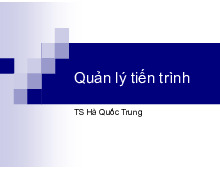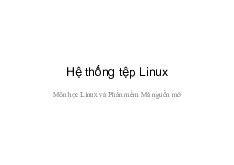











Preview text:
KHỞI ĐỘNG HỆ THỐNG Outline Overview System startup
• booting Linux begins in the BIOS at address 0xFFFF0.
• The first step of the BIOS is the power-on
self test (POST). The job of the POST is
to perform a check of the hardware.
• The second step of the BIOS is local
device enumeration and initialization.
• the BIOS is made up of two parts:
– the POST code (the power-on self test)
– runtime services: searches for devices that are both
active and bootable (a floppy disk, a CD-ROM, a
partition on a hard disk, a device on the network, or
even a USB flash memory stick)
• Commonly, Linux is booted from a hard disk, where
the Master Boot Record (MBR) contains the
primary boot loader. The MBR is a 512-byte sector,
located in the first sector on the disk (sector 1 of
cylinder 0, head 0). After the MBR is loaded into
RAM, the BIOS yields control to it. Stage 1 boot loader Stage 2 boot loader • It’s a kernel loader
• The first- and second-stage boot loaders
combined are called Linux Loader (LILO)
or GRand Unified Bootloader (GRUB) in the x86 PC environment.
• Instead of using raw sectors on the disk,
as LILO does, GRUB can load a Linux
kernel from an ext2 or ext3 file system. GRUB
• Stage 1 (MBR) boots a stage 1.5 boot
loader that understands the particular file
system containing the Linux kernel image.
• Examples include reiserfs_stage1_5 (to
load from a Reiser journaling file system) or
e2fs_stage1_5 (to load from an ext2 or ext3 file system).
• Stage 2: the default kernel image and initrd image are loaded into memory.
• With the images ready, the stage 2 boot
loader invokes the kernel image. Kernel
• With the kernel image in memory and
control given from the stage 2 boot loader, the kernel stage begins.
• Typically this is a zImage (compressed
image, less than 512KB) or a bzImage
(big compressed image, greater than 512KB) Major functions flow for the Linux kernel i386 boot Init
• After the kernel is booted and initialized, the
kernel starts the first user-space application.
This is the first program invoked that is
compiled with the standard C library.
• In a desktop Linux system, the first
application started is commonly /sbin/init.
But it need not be. Rarely do embedded
systems require the extensive initialization
provided by init (as configured through /etc/inittab)



